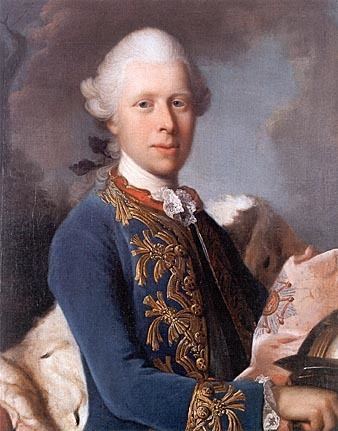Reign 1772–1804 Name Ernest Duke | ||
 | ||
Born 30 January 1745Gotha ( 1745-01-30 ) Issue Ernest, Hereditary Prince of Saxe-Gotha-AltenburgAugustusFrederick IVPrince Ludwig Died April 20, 1804, Gotha, Germany Children Augustus, Duke of Saxe-Gotha-Altenburg, Frederick IV, Duke of Saxe-Gotha-Altenburg Parents Princess Luise Dorothea of Saxe-Meiningen, Frederick III, Duke of Saxe-Gotha-Altenburg Grandchildren Princess Louise of Saxe-Gotha-Altenburg | ||
Ernest II, Duke of Saxe-Gotha-Altenburg (Gotha, 30 January 1745 – Gotha, 20 April 1804) was the reigning Duke of Saxe-Gotha-Altenburg from 1772 to 1804. He was the third but second surviving son of Frederick III, Duke of Saxe-Gotha-Altenburg and Luise Dorothea of Saxe-Meiningen. The death of his older brother Frederick in 1756 made him the heir to the duchy of Saxe-Gotha-Altenburg.
Contents
Early life
Luise Dorothea was intensely worried about the training of her surviving sons, Ernest and her youngest son August, and had them educated by a select group of teachers. In 1768 and 1769, both princes went on an educational journey to the Netherlands, England and France, and Ernest met important people in politics, science and the arts.
Succession
In 1772 his father died, and Ernest inherited the duchy of Saxe-Gotha-Altenburg. As a liberal and enlightened prince, he was interested in the arts and sciences and used his reign to further them. He promoted the educational system, the economy, theatre, art collections and libraries as well as the natural sciences in his duchy, which was thereby ranked in the top place of the Saxon duchies in Thuringia. Privately, he was particularly interested in astronomy and physics. He appointed competent specialists in all of these areas like the mechanic and clockmaker Johann Andreas Klindworth to whom he granted the title of court mechanic.
For his special interests, he employed the services of the important astronomer Franz Xaver von Zach for Gotha. With him, he established the Observatory of Gotha (Sternwarte Gotha), which developed into a European centre of astronomy. His will stated that this institution should survive as the only visible indication of his existence. It was so successful that Gotha, despite its size, was thought of as a place that important people of the time should visit. One such person was Goethe, who visited several times.
Freemasonry
From 1774 he was a Freemason in the Zinnendorf system and a member of the Gotha Lodge Zum Rautenkranz, which had been founded by Abel Seyler, Konrad Ekhof and other members of the Seyler Theatre Company in the same year. In 1775, he was appointed Grand Master of the Landesloge of Germany (Zinnendorf system). In 1783, he became a member of the Bavarian Illuminati under the name of Quintus Severus and/or Timoleon, and in 1784, he was made Supervisor of Abessinien (a name for Upper Saxony). In 1787, he granted Adam Weishaupt, the founder of the secret society, asylum in Gotha. He was buried wrapped in a white cloth on the park island.
Descendants
In Meiningen on 21 March 1769, Ernest married Princess Charlotte of Saxe-Meiningen, the cousin of his mother. They had four sons:
